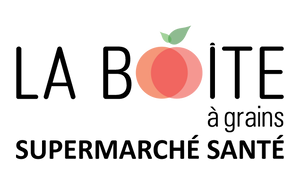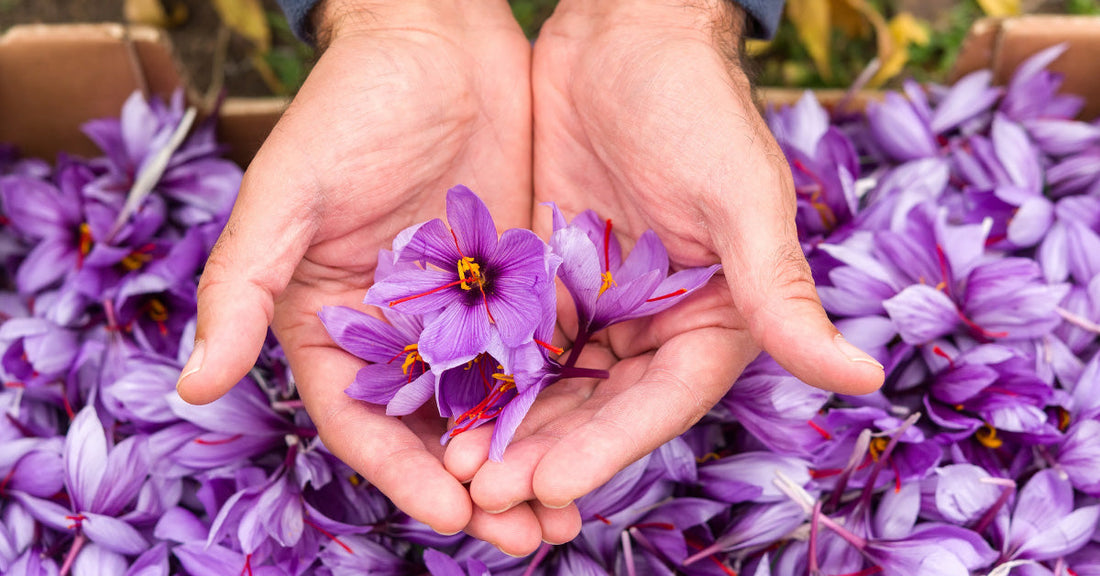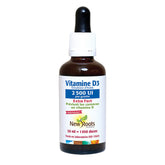What is saffron?
Saffron is the only spice made of the stigmata of a flower, that of the Crocus Sativus of its Latin name. It is also called "red gold" since this spice is the most expensive in the world. It belongs to the Iridaceae family which also includes iris and gladiors. Its cost comes from its delicate and colossal picking, because, to make a kilo of saffron, it takes 150,000 flowers and take 3 stigma of the pistil. The stigma are very pronounced red in color.5, 6, 10, 17
How is it cultivated?
The saffron is a perennial herbaceous which is akin to a bulb "Crocus sativus" buried a few fifteen centimeters deep, and which multiplies each year by producing new bulbs.
In Quebec, it is at the end of the summer, when the days shortened and the nights are cooler, that the bulb begins its flowering cycle. It is around the beginning of fall (September 21) that we can see leaves appear.17
History of saffron
Its use dates back more than 5000 years and crosses several companies, continents and civilizations. At the very beginning, the saffron would have been born between Turkey and India to spread around the eastern Mediterranean basin.
Today, saffron is cultivated throughout the east (especially in countries like Iran and India), in Morocco, in the countries of southern Europe such as Greece, Switzerland, Austria, in England and France is also a large center of this business.5, 6, 10
In its history, saffron has been used as seasoning, dyeing, perfume and medication.
Saffron, a concentrate of antioxidants and benefits
150 different molecules are associated with the stigma of the Crocus sativus saffron, including carotenoids (a-crocine, picrocrocine), lycopens and zeaxanthine responsible for the pronounced color of orange red.
This pigment turns into vitamin A in the intestine, which plays a major role in the quality of our vision (acuity, night vision and resistance to the harmful effects of aging).
Zeaxanthine is one of the carotenoids present naturally in the retina of the human eye.
Safranal is this molecule which appears at the time of drying the plant which is responsible for anti-stress powers and mood regulator such as anxiety and depression.
Crocine contributes to normalizing the serotonin level, a neurotransmitter responsible for mood.
All these compounds (crocine, picrocrocine, safranal) are powerful antioxidants and anti-inflammatory drugs and could protect brain functions while reducing the risk of depression and chronic diseases.6, 10, 17
Essential vitamins and minerals
The saffron is rich in minerals and trace elements such as: calcium, copper, iron, magnesium, manganese, phosphorus, potassium, sodium, zinc.
It also contains vitamins: E, C, B1 or Thiamine, B2 or Riboflavine, B3 or PP or Niacine, B6 and B9 as well as beta-carotene (vitamin A pioneer).6, 10
It also contains proteins, carbohydrates, lipids, starch and fibers, etc..6, 10
How to cook the saffron?
To use the saffron, it is recommended to make an infusion of stigma in a lukewarm liquid (coconut milk, milk, broth, water, alcohol, wine, etc.) for a minimum of 4 hours and never boil it.
We don't cook the saffron, we add it at the end of cooking. 5-10 minutes will be enough to get his aromas out. 2 stigma per person is enough.8
Being used in the kitchen, this plant is however poorly known for its medicinal properties.
Saffron, an adaptogenic plant
The saffron has many virtues and its medicinal use dates back thousands of years. It is one of the metabolic regulatory plants which make it possible to increase the adaptability of the organism in the face of various environmental stresses by providing normalizing action at the physiological level.15
Saffron has more than a hundred different chemical compounds, which in the son of time and cultures have earned it a remedy status for several ailments, of which here are some here.6, 17
Safran secrets on mental health

Saffron is remarkable for its action on the nervous system. Its constituent, the crocine participates in reducing mood disorders, anxiety and promotes the production of serotonin and dopamine, two neurotransmitters present in the brain.6, 17
The role of serotonin and dopamine
Serotonin acts in particular in the regulation of mood, alternation of sleep, appetite, perception of pain, etc.
Dopamine is the hormone responsible for regulating motivation, pleasure and our inner dynamism.7
Safranal, a precious active compound
Safranal is another active compound that acts as antioxidant, with anti-inflammatory virtues, and used to help relieve mood disorders. It has antidepressive properties.
Studies explain that the Safranal has an effectiveness equal to the flowetine or imipramine which are the molecules that are found in the antidepressants of Prozac and Toframil.6, 7, 17
First clinical test on saffron
"Results of the first clinical trial on saffron in the treatment of depression and published in 2004, carried out by Professor Akhondzadeh, now vice-dean of research at the University of Medical Sciences in Tehran in Iran. During This study, 30 milligrams (MG) of Safran were administered daily to 15 participants with depression and compared to 15 other participants who received a tricyclic antidepressant. weeks. "9
Other benefits of saffron to know
Digestion
Like many spices, the saffron is carminative, that is to say that it helps to fight bloating and gases. In Chinese medicine, it is said that saffron has a warming action like ginger. It helps slow and lazy digestion.
In small doses and infusion, saffron makes it possible to stimulate and encourage good digestive activity by also stimulating the liver.6, 10, 17
Soothing properties
Saffron would be recommended for muscle cramps and muscle pain in addition to promoting good sleep.6, 10, 17
Perimenopause and mood
During this period of hormonal changes, mood disorders can be felt. Crocine, active ingredient of saffron, will come to the rescue to normalize serotonin.1, 9, 10
Libido and menopause
Menopause is associated with a decrease in libido which is attributable to hormonal changes of a lower level of estrogen. Saffron could be used to stimulate libido.1, 10
Aging
Saffron, a real concentrate of antioxidants that help reduce oxidative stress associated with aging.1, 10
Emmenagogue
The saffron is emmenagogue, that is to say it facilitates the menstruation which are slow to arrive.10
Male libido and erection
Safran also stimulates libido in humans. It acts as a natural tonic of sexual function. Studies show that supplementation for 10 days would have an action on erectile dysfunction and also on the increase in the volume of sperm.10
A natural solution: Zen saffron from New Roots Herbal
Zen saffron from New Roots Herbal is produced with clinically experienced extract, derived from saffron stigma (Crocus sativus), a powerful formula containing 14 mg (3.5% lepticrosalides) providing crocines and safranal.4, 6, 17
Mood balance and helps reduce stress (without prescription). It is indicated for adolescents aged 12 and over and adults.4
Safran Zen helps relieve stress, improves mood, sleep quality and mood upon waking. It also helps to relieve agitation, nervousness, fatigue, weariness and irritability.4
Safran Zen is certified by an ISO 17025 certified laboratory, so no risk of fraudulent ingredients.4
Additional supplements to the saffron to support the mood
Vitamin D
Nicknamed "sun vitamin", Vitamin D has a direct impact on our mood.
According to data, the majority of people living in the northern hemisphere of the planet have a vitamin D deficiency because of the lack of light during the winter. It is therefore essential to take a vitamin D supplement to cover our needs knowing that food alone (especially with fatty fish, eggs, enriched dairy products, and offs) is not enough.11
Do you know seasonal depression? It is a form of depression which is directly linked with seasonal changes and manifests itself every year.
Symptoms accentuate as fall advances, and last until spring. This is explained by the hours of sunshine reduced in the fall and winter, which causes a drop in serotonin, a neurotransmitter that contributes to regularizing our mood. Serotonin on its side also triggers our production of melatonin, this hormone which facilitates falling asleep and which affects our sleep cycles. Who says bad sleep says fatigue that accumulates over time. Nothing to help mood.11
Probiotics
Taking care of your microbiota is taking care of your mental health.
Our intestine is populated by billions of good "bacteria" which protect us in multiple ways. Probiotics, these "friends" bacteria discourage the implementation of powerful microbes and form a protective barrier that prevents unwanted organisms from passing through our blood. They complete food digestion, ensure good nutrient assimilation capacity and participate in a strong immune system.2, 3
The microbiota-intestine-end axis
Scientists now know that the intestine and the brain communicate between them in a constant, dynamic and bidirectional way. This communication between the intestine and the brain is called "the microbiota-intestine-end axis". The vagus nerve is a channel for the transmission of information from this "microbiota-intensin-ending axis". The vagus nerve is the longest nerve of the human body, it arises in the brainstem and detects, treats, regulates the vast majority of the automatic functions of our organism by our autonomic nervous system.2, 3
Serotonin, nicknamed "the chemical of happiness" is also produced and stored 95% in the intestine.2, 3
A healthy intestine can:
- Decrease stress reaction
- decrease
- Check cortisol levels (stress hormone)
- Improve memory
- brake inflammation, which is the cause of many diseases3
The probiotic and its functions
- Restore the microbiota balance
- strengthens the immune system
- Promotes the assimilation of certain minerals (calcium, magnesium, iron, zinc) and certain vitamins (B-Incomplex, K2)
- Facilitates communication between the intestine and certain brain neurotransmitters
- Participate in the manufacture of anti-inflammatory substances14
About the author
Marie Couture, a graduate naturopath
Marie Couture contact details:
- Visit the profile Linkedin of Marie Couture
- E-mail : marieclabellevie@hotmail.com
- Phone : 819-210-8978
- Find Marie Couture on Google Maps
Discover all profiles of our experts!
References:
- Desautels Dre Lyne, Huot Isabelle, Doctor of Nutrition, Better living menopause, Les Éditions de l'Homme, 2023, 243 pages
- Habib Dr. Navaz, activate your vagus nerve, Thierry Souccar editions, 2020, 238 pages
- Thérien Paul, Sept. 13, 2022, The intestine Our second brain?, The health week
- https://newrootsherbal.com/product/id/3387















